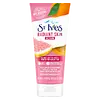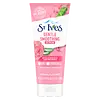What's inside
What's inside
 Key Ingredients
Key Ingredients

 Benefits
Benefits

 Concerns
Concerns

 Ingredients Side-by-side
Ingredients Side-by-side

Water
Skin ConditioningJuglans Regia Shell Powder
AbrasiveGlycerin
HumectantSodium Methyl 2-Sulfolaurate
CleansingDecyl Glucoside
CleansingAcrylates Copolymer
Acrylates/Palmeth-25 Acrylate Copolymer
Cocamidopropyl Betaine
CleansingDisodium 2-Sulfolaurate
CleansingCitrus Limon Peel Powder
AbsorbentCocamidopropyl Pg-Dimonium Chloride Phosphate
Phenoxyethanol
PreservativeParfum
MaskingDisodium EDTA
Polyacrylamide
Iodopropynyl Butylcarbamate
PreservativeCitrus Nobilis Peel Extract
MaskingCitrus Limon Fruit Extract
MaskingHexyl Cinnamal
PerfumingLimonene
PerfumingCI 77891
Cosmetic ColorantCI 17200
Cosmetic ColorantWater, Juglans Regia Shell Powder, Glycerin, Sodium Methyl 2-Sulfolaurate, Decyl Glucoside, Acrylates Copolymer, Acrylates/Palmeth-25 Acrylate Copolymer, Cocamidopropyl Betaine, Disodium 2-Sulfolaurate, Citrus Limon Peel Powder, Cocamidopropyl Pg-Dimonium Chloride Phosphate, Phenoxyethanol, Parfum, Disodium EDTA, Polyacrylamide, Iodopropynyl Butylcarbamate, Citrus Nobilis Peel Extract, Citrus Limon Fruit Extract, Hexyl Cinnamal, Limonene, CI 77891, CI 17200
Water
Skin ConditioningGlyceryl Stearate Se
EmulsifyingGlycerin
HumectantJuglans Regia Shell Powder
AbrasiveCetearyl Alcohol
EmollientCetyl Alcohol
EmollientSodium Lauryl Sulfoacetate
CleansingCocamidopropyl Betaine
CleansingGlyceryl Stearate
EmollientPEG-100 Stearate
Cetyl Acetate
EmollientParfum
MaskingBenzyl Alcohol
PerfumingRosa Gallica Flower Powder
Skin ConditioningCeteareth-20
CleansingTriethanolamine
BufferingCarbomer
Emulsion StabilisingPolysorbate 60
EmulsifyingDisodium EDTA
Benzoic Acid
MaskingAcetylated Lanolin Alcohol
EmollientSorbic Acid
PreservativeRosa Damascena Flower Extract
MaskingAloe Barbadensis Leaf Extract
EmollientCinnamyl Alcohol
PerfumingCitral
PerfumingCitronellol
PerfumingGeraniol
PerfumingHexyl Cinnamal
PerfumingLimonene
PerfumingLinalool
PerfumingCI 77891
Cosmetic ColorantWater, Glyceryl Stearate Se, Glycerin, Juglans Regia Shell Powder, Cetearyl Alcohol, Cetyl Alcohol, Sodium Lauryl Sulfoacetate, Cocamidopropyl Betaine, Glyceryl Stearate, PEG-100 Stearate, Cetyl Acetate, Parfum, Benzyl Alcohol, Rosa Gallica Flower Powder, Ceteareth-20, Triethanolamine, Carbomer, Polysorbate 60, Disodium EDTA, Benzoic Acid, Acetylated Lanolin Alcohol, Sorbic Acid, Rosa Damascena Flower Extract, Aloe Barbadensis Leaf Extract, Cinnamyl Alcohol, Citral, Citronellol, Geraniol, Hexyl Cinnamal, Limonene, Linalool, CI 77891
 Reviews
Reviews

Ingredients Explained
These ingredients are found in both products.
Ingredients higher up in an ingredient list are typically present in a larger amount.
Ci 77891 is a white pigment from Titanium dioxide. It is naturally found in minerals such as rutile and ilmenite.
It's main function is to add a white color to cosmetics. It can also be mixed with other colors to create different shades.
Ci 77891 is commonly found in sunscreens due to its ability to block UV rays.
Learn more about CI 77891Cocamidopropyl Betaine is a fatty acid created by mixing similar compounds in coconut oil and dimethylaminopropylamine, a compound with two amino groups.
This ingredient is a surfactant and cleanser. It helps gather the dirt, pollutants, and other impurities in your skin to be washed away. It also helps thicken a product and make the texture more creamy.
Being created from coconut oil means Cocamidopropyl Betaine is hydrating for the skin.
While Cocamidopropyl Betaine was believed to be an allergen, a study from 2012 disproved this. It found two compounds in unpure Cocamidopropyl Betaine to be the irritants: aminoamide and 3-dimethylaminopropylamine. High-grade and pure Cocamidopropyl Betaine did not induce allergic reactions during this study.
Learn more about Cocamidopropyl BetaineDisodium EDTA plays a role in making products more stable by aiding other preservatives.
It is a chelating agent, meaning it neutralizes metal ions that may be found in a product.
Disodium EDTA is a salt of edetic acid and is found to be safe in cosmetic ingredients.
Learn more about Disodium EDTAGlycerin is already naturally found in your skin. It helps moisturize and protect your skin.
A study from 2016 found glycerin to be more effective as a humectant than AHAs and hyaluronic acid.
As a humectant, it helps the skin stay hydrated by pulling moisture to your skin. The low molecular weight of glycerin allows it to pull moisture into the deeper layers of your skin.
Hydrated skin improves your skin barrier; Your skin barrier helps protect against irritants and bacteria.
Glycerin has also been found to have antimicrobial and antiviral properties. Due to these properties, glycerin is often used in wound and burn treatments.
In cosmetics, glycerin is usually derived from plants such as soybean or palm. However, it can also be sourced from animals, such as tallow or animal fat.
This ingredient is organic, colorless, odorless, and non-toxic.
Glycerin is the name for this ingredient in American English. British English uses Glycerol/Glycerine.
Learn more about GlycerinHexyl Cinnamal is a fragrance ingredient with a similar scent to jasmine. It can be naturally found in chamomile essential oil.
This ingredient is a known EU allergen and may sensitize the skin. The EU requires this ingredient to be listed separately on an ingredients list.
Hexyl Cinnamal is not water soluble but is soluble in oils.
Learn more about Hexyl CinnamalYou might know this ingredient as walnut shell powder. It is an abrasive used as a physical exfoliator.
Abrasives are physical exfoliants used to get rid of dead cell buildup on your skin. Physical exfoliators have a bad reputation due to the myth that they give your face tiny cuts. This is untrue.
Like any exfoliant, using this ingredient can disrupt your skin barrier. This can lead to breakouts, irritation, and dryness. It is critical to be gentle when using any type of exfoliator.
If you want to use a chemical exfoliator instead, check out glycolic acid.
Learn more about Juglans Regia Shell PowderLimonene is a fragrance that adds scent and taste to a formulation.
It's found in the peel oil of citrus fruits and other plants such as lavender and eucalyptus. The scent of limonene is generally described as "sweet citrus".
Limonene acts as an antioxidant, meaning it helps neutralize free radicals.
When exposed to air, oxidized limonene may sensitize the skin. Because of this, limonene is often avoided by people with sensitive skin.
The term 'fragrance' is not regulated in many countries. In many cases, it is up to the brand to define this term. For instance, many brands choose to label themselves as "fragrance-free" because they are not using synthetic fragrances. However, their products may still contain ingredients such as essential oils that are considered a fragrance.
Learn more about LimoneneParfum is a catch-all term for an ingredient or more that is used to give a scent to products.
Also called "fragrance", this ingredient can be a blend of hundreds of chemicals or plant oils. This means every product with "fragrance" or "parfum" in the ingredients list is a different mixture.
For instance, Habanolide is a proprietary trade name for a specific aroma chemical. When used as a fragrance ingredient in cosmetics, most aroma chemicals fall under the broad labeling category of “FRAGRANCE” or “PARFUM” according to EU and US regulations.
The term 'parfum' or 'fragrance' is not regulated in many countries. In many cases, it is up to the brand to define this term.
For instance, many brands choose to label themselves as "fragrance-free" because they are not using synthetic fragrances. However, their products may still contain ingredients such as essential oils that are considered a fragrance by INCI standards.
One example is Calendula flower extract. Calendula is an essential oil that still imparts a scent or 'fragrance'.
Depending on the blend, the ingredients in the mixture can cause allergies and sensitivities on the skin. Some ingredients that are known EU allergens include linalool and citronellol.
Parfum can also be used to mask or cover an unpleasant scent.
The bottom line is: not all fragrances/parfum/ingredients are created equally. If you are worried about fragrances, we recommend taking a closer look at an ingredient. And of course, we always recommend speaking with a professional.
Learn more about ParfumWater. It's the most common cosmetic ingredient of all. You'll usually see it at the top of ingredient lists, meaning that it makes up the largest part of the product.
So why is it so popular? Water most often acts as a solvent - this means that it helps dissolve other ingredients into the formulation.
You'll also recognize water as that liquid we all need to stay alive. If you see this, drink a glass of water. Stay hydrated!
Learn more about Water